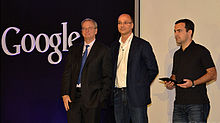Write a brief history of Android.
A.
History of Android
Android, Inc. was founded in Palo Alto, California in October 2003 by Andy Rubin (co-founder of Danger),[24] Rich Miner (co-founder of Wildfire Communications, Inc.),[25] Nick Sears (once VP at T-Mobile),[26] and Chris White (headed design and interface development at WebTV[12]) to develop, in Rubin's words, "smarter mobile devices that are more aware of its owner's location and preferences".[12] The early intentions of the company were to develop an advanced operating system for digital cameras. Though, when it was realized that the market for the devices was not large enough, the company diverted its efforts toward producing a smartphone operating system that would rival Symbian and Microsoft Windows Mobile.[27] Despite the past accomplishments of the founders and early employees, Android Inc. operated secretly, revealing only that it was working on software for mobile phones.[12] That same year, Rubin ran out of money. Steve Perlman, a close friend of Rubin, brought him $10,000 in cash in an envelope and refused a stake in the company.[28]
In July 2005, Google acquired Android Inc. for at least $50 million, whose key employees, including Rubin, Miner and White, stayed at the company after the acquisition.[11][12] Not much was known about Android Inc. at the time, but many assumed that Google was planning to enter the mobile phone market with this move.[12] At Google, the team led by Rubin developed a mobile device platform powered by the Linux kernel. Google marketed the platform to handset makers andcarriers on the promise of providing a flexible, upgradable system. Google had lined up a series of hardware component and software partners and signaled to carriers that it was open to various degrees of cooperation on their part.[29][30][31]
Speculation about Google's intention to enter the mobile communications market continued to build through December 2006.[32] An earlier prototype codenamed "Sooner" had a closer resemblance to a BlackBerry phone, with no touchscreen, and a physical, QWERTY keyboard, but was later re-engineered to support a touchscreen, to compete with other announced devices such as the 2006 LG Prada and 2007 Apple iPhone.[33][34] In September 2007, InformationWeek covered anEvalueserve study reporting that Google had filed several patent applications in the area of mobile telephony.[35][36]
Eric Schmidt, Andy Rubin and Hugo Barra at a 2012 press conference
announcing Google's Nexus 7 tablet
announcing Google's Nexus 7 tablet
On November 5, 2007, the Open Handset Alliance, a consortium of technology companies including Google, device manufacturers such as HTC, Sony and Samsung, wireless carriers such as Sprint Nextel and T-Mobile, and chipset makers such as Qualcomm and Texas Instruments, unveiled itself, with a goal to develop open standards for mobile devices.[13]That day, Android was unveiled as its first product, a mobile device platform built on the Linux kernel.[13][37] The first commercially available smartphone running Android was the HTC Dream, released on October 22, 2008.[38]
Since 2008, Android has seen numerous updates which have incrementally improved the operating system, adding new features and fixing bugs in previous releases. Each major release is named in alphabetical order after a dessert or sugary treat; for example, version 1.5 "Cupcake" was followed by 1.6 "Donut". In 2010, Google launched its Nexus series of devices – a line of smartphones and tablets running the Android operating system, and built by manufacturing partners. HTC collaborated with Google to release the first Nexus smartphone,[39] the Nexus One. Google has since updated the series with newer devices, such as the Nexus 5 phone (made by LG) and the Nexus 7 tablet (made by Asus). Google releases the Nexus phones and tablets to act as their flagship Android devices, demonstrating Android's latest software and hardware features. From 2013 until 2015, Google offered several Google Play Editiondevices over Google Play. While not carrying the Google Nexus branding, these were Google-customized Android phones and tablets that also ran the latest version of Android, free from manufacturer or carrier modifications.
From 2010 to 2013, Hugo Barra served as product spokesperson, representing Android at press conferences and Google I/O, Google’s annual developer-focused conference. Barra's product involvement included the entire Android ecosystem of software and hardware, including Honeycomb, Ice Cream Sandwich, Jelly Bean and KitKat operating system launches, the Nexus 4 and Nexus 5 smartphones, the Nexus 7[40] and Nexus 10 tablets,[41] and other related products such as Google Now[42] and Google Voice Search, Google’s speech recognition product comparable to Apple’s Siri.[42] In 2013, Barra left the Android team for Chinese smartphone maker Xiaomi.[43] The same year, Larry Page announced in a blog post that Andy Rubin had moved from the Android division to take on new projects at Google.[44]He was replaced by Sundar Pichai who became the new head of Android and Chrome OS,[45] and, later, by Hiroshi Lockheimer when Pichai became CEO of Google.[46]
In 2014, Google launched Android One, a line of smartphones mainly targeting customers in the developing world. In May 2015, Google announced Project Brillo as a cut-down version of Android that uses its lower levels (excluding the user interface), intended for the "Internet of Things" (IoT) embedded systems.[47]
Ref:
https://en.wikipedia.org/wiki/Android_(operating_system)

No comments:
Post a Comment